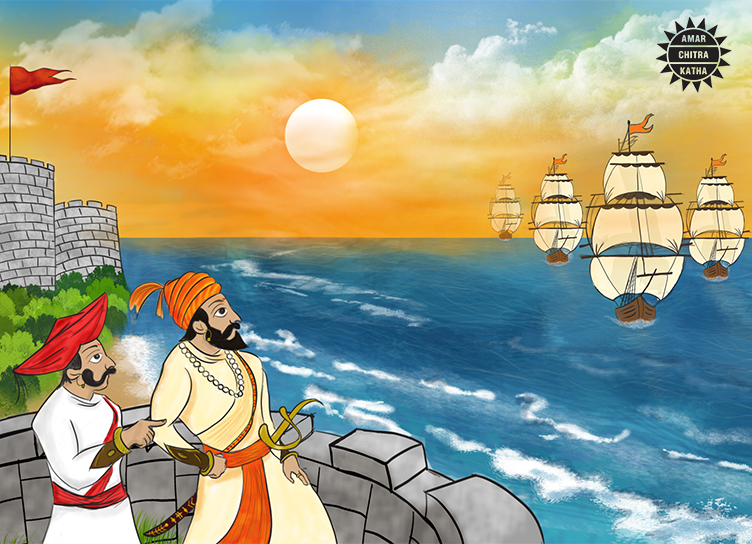Chhatrapati Sambhaji Maharaj
- January 24, 2025


Chhatrapati Sambhaji Maharaj
- January 24, 2025
By Mahima Sankar
Chhatrapati Shivaji Maharaj is well-known as the founder of the Maratha Empire, but what of the other leaders who continued his legacy? After Shivaji Maharaj, it was his oldest son – Chhatrapati Sambhaji – who went on to expand his father’s empire, becoming one of the most formidable Maratha leaders.
Read more about the brave warriors in Indian history here
To receive more such stories in your Inbox & WhatsApp, Please share your Email and Mobile number.
Sambhaji was born in 1657, two years after which, his mother passed away. He was sent to live in Amber as a political hostage at the age of nine. Young Sambhaji’s mettle would be tested even further, when he and his father were invited to visit the court of Mughal Emperor, Aurangzeb, in Agra. Under the guise of friendship, the two were trapped and kept under house arrest. Stories abound that when Aurangzeb asked the young prince if he was scared of him, Sambhaji replied, “I fear no one – people fear me.”
Cleverly, Shivaji Maharaj managed to escape from Agra with his son, smuggled in boxes meant to contain fruits. Then, Sambhaji was handed over to allies in Mathura while his father undertook the treacherous journey back home to Rajgad on his own. There, Shivaji spread rumours that the prince had died on the way home and even performed his last rites. When the Mughals were convinced that the prince was dead and stopped looking for him, Sambhaji travelled back hundreds of miles on foot with his father’s friends, finally making it back to his family.
Read more about the brave warriors in Indian history here
Through his teenage years, Sambhaji successfully conducted political negotiations with the English and was involved in several court judgements. He was a good warrior who successfully ran a major military campaign in Hubli, and was said to have defeated a lion with his bare hands in defence of one of his men! Despite all this, he was sometimes reckless like young men often are. His behaviour once led Shivaji to send him away from the capital. Disgruntled, Sambhaji went to stay with Diler Khan, a Mughal commander, until they set out to capture Panhala. Witnessing Khan’s butchering of the gentry, both Hindu and Muslim, in the town of Tikota, opened Sambhaji’s eyes to Khan’s cruelty. Fearing for his own safety, he eventually fled and returned home after almost a year away. Back at the Maratha court, Shivaji’s second wife, Soyrabai, had used Sambhaji’s absence to promote her young son, Rajaram, and installed him on the throne after Chhatrapati Shivaji’s death in 1680. It wasn’t until 1681 that Sambhaji was able to overthrow him and take his rightful place on the throne.

Sambhaji would go on to promote his father’s ideal of Swarajya or self-rule through his campaigns against Aurangzeb and European invaders. This was the same ideal that inspired him to create systems of justice that empowered his subjects. While he is well-known as a champion of Hinduism, due to his efforts to promote Maratha Hindu sovereignty and culture, Sambhaji firmly believed in tolerance and distributed grants to sacred places from all religions. When drought struck the region during the early years of his rule, he built new irrigation systems and distributed food and land to landless farmers. He even pardoned those who had fled due to their inability to pay taxes, and encouraged them to return and increase cultivation.
As a poet and musician himself, Sambhaji Maharaj was a big patron of the arts. His court was a melting pot of scholars, artists, and performers invited from all over India. A poet friend inspired in him a love of languages, and it is believed that the king spoke several fluently – including Marathi, Sanskrit, Hindi, Persian, English, and Portuguese – a talent that he deployed to great political success. He even wrote a treatise in Sanskrit, Budhbhushanam, a work on politics and military defence for the benefit of future kings.
Read more about the brave warriors in Indian history here
Chhatrapati Shivaji’s death unfortunately brought about the end of the relatively stable relations with the Mughals and other regional powers. Sambhaji Maharaj took the throne and ultimately spent the rest of his life expanding and defending the Maratha Empire. To start with, he developed the navy his father had created, and brokered deals with the English to obtain weapons. When the Portuguese implemented forced conversions and destroyed Hindu temples in Goa, he fought back and conquered large parts of the Konkan coast, gaining control of many valuable ports.
Recognising the threat the Marathas posed to the Mughal Empire, Aurangzeb left Delhi and marched towards the Deccan. Sambhaji successfully defended his kingdom for nine years until he was betrayed by Soyrabai and her supporters, and captured by Aurangzeb. When he refused Aurangzeb’s orders to accept him as his sovereign ruler and convert to Islam, Sambhaji Maharaj was brutally tortured and killed.
While Rajaram was placed on the throne immediately after his death, Chhatrapati Sambhaji’s sacrifice allowed the Maratha Empire to survive independently as a stronghold in Central India, away from Aurangzeb’s conquests. The Maharaj, fondly referred to as chaava or lion cub, remains respected till date, for the care he showed his people and the sacrifices he made to safeguard their freedom.
Read more about the brave warriors in Indian history here
To receive more such stories in your Inbox & WhatsApp, Please share your Email and Mobile number.

Comic of The Month
The Naval Journey of India Book I
This book is the first of a three-book series that takes a deep and detailed look at India's Naval History and a deep insight into the lives of our men and women in white. But any series on the Indian Navy has to start at the very beginning - exploring India's celebrated maritime history. Join our little hero, Bharat, and his grandfather, Commodore Sagar, as they sail into the deep blue waters of time. Book I of The Naval Journey of India takes a sweeping look at India's maritime endeavours, how the seas impacted us over millennia and how the oceans made us who we are.